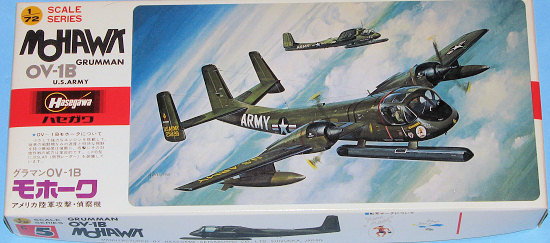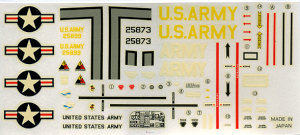
| KIT: | Hasegawa 1/72 OV-1B Mohawk |
| KIT #: | C 005 |
| PRICE: | 450 yen when new (at that time, about $1.30) |
| DECALS: | One option |
| REVIEWER: | Scott Van Aken |
| NOTES: |

| HISTORY |
The Grumman OV-1 Mohawk was a heavily armored and armed military observation and attack aircraft, designed for battlefield surveillance and light strike capabilities. It was of twin turboprop configuration, and carried two crewmembers with side-by-side seating. The Mohawk was intended to operate from short, unimproved runways in support of Army maneuver forces.
The prototype (YAO-1AF) first flew on April 14, 1959. The OV-1 entered production in October 1959 and served the U.S. Army in Europe, Korea, Vietnam, Central and South America, Alaska, and during Operation Desert Storm in the Middle East. The Mohawk was removed from U.S. Army service in September 1996.
Over the years, the mission and the aircraft underwent many changes. About 380 of the aircraft were built, and deployed in Vietnam, Germany, Desert Storm and Korea. Mohawk variants included the JOV-1 [armed reconnaissance], OV-1A, [visual and photographic], OV-1B [visual, photographic, and side-looking radar (SLAR) pod], the OV-1C [ visual, photographic, and infrared], and the OV-1D (SLAR pod and bigger wings), OV-1E [enlarged fuselage for more sensor operators or cargo], EV-1E [Special electronic intelligence installation] and RV-1E [advanced ELINT Reconnaissance]. A four-engined Model 134E with tiltwings and tail ducted fan for control for VTOL was proposed to the Army but not built. Model 134R was a tandem cockpit version offered to meet the LARA requirement, but the NA300 was chosen instead becoming the OV-10.
The Mohawk was intended to replace began as a joint Army-Marine program, through the Navy aeronautical bureau, for an observation/attack plan that would outperform the Cessna L-19 Bird Dog. In June of 1956, the Army issued Type Specificationn TS145, which called for the development and procurement of a two-seat, twin turboprop aircraft designed to operate from small, unimproved fields under all weather conditions. It would be faster, with greater firepower, and heavier armour than the Bird Dog, which had proved vulnerable during the Korean War. The Mohawk's mission would include observation, artillery spotting, air control, emergency resupply, naval target spotting, liaison, and radiological monitoring. The Navy specified that the aircraft must be capable of operating from small "jeep" escort class carriers (CVEs). The DoD selected Grumman Aircraft Corporation's G-134 design as the winner of the competition in 1957.
The Air Force did not like the armament capability of the Mohawk and tried to get it removed. The Marines did not want the sophisticated sensors the Army wanted, so when their Navy sponsors opted to buy a fleet oil tanker, they dropped from the program. The Army continued with armed Mohawks and developed cargo pods that could be dropped from underwing hard points to resupply troops in emergencies. Pilots and enlisted observers in Mohawks in Vietnam would detect the Viet Cong and North Vietnamese enemy by virtue of their excellent downward visibility (afforded by the bubble canopy) as well as sensors, and immediately attack them with 2.75 inch rockets and .50-caliber heavy machine gun pod fire. The twin T53 turbine engines mounted horizontally, turning 3-bladed propellers, were very quiet so the VC/NVA did not hear them coming. In contrast, a single T53 turbine mounted vertically, so as to spin a large rotor blade as in Huey or Huey-Cobra helicopters, gives off a loud"wop-wop-wop" sound detectable from miles away. The VC/NVA referred to the Mohawks as the "Whispering Death". One Mohawk even shot down a NVAF MIG-17 in combat. Captain Ken Lee shot down a MIG-17 in 1968 while operating in Laos along the border with North Vietnam. Army field commanders needed their own fixed-wing aircraft capable of providing fast reactive air support from forward operating bases since they could be on the scene much faster than USAF aircraft requiring longer, paved runways on bases farther back from the battlefield.
Pressures from the USAF caused the Army to downplay the armed nature of their Mohawks who were shifted from division-level control to higher echelon control resulting in their under-utilization as mere observation platforms; a practice that continued all the way to 1996. The result was the Army was forced to fly several companies (squadrons) of O-1 Bird Dogs over Vietnam in order to find and coordinate strikes on the skilled-at-camouflage VC/NVA; needlessly exposing their men to downings while the AF and Marines finally replaced their Bird Dogs with OV-10 Broncos, which were essentially a rehash of the Army's 1954 observation/attack aircraft requirement.
Outside the U.S. Army, the military operators of the Mohawk have been the South Korean Air Force Israeli Air Force and the Argentine Army where it is still in service.
| THE KIT |
 This is old school Hasegawa at its best. You have several sprues of olive parts which are well molded, though they do sport raised panel lines. I guess you could call this phase I Hasegawa as this kit is somewhat newer than the F-102/106 types, but not yet up to the current phase of kits which started around the time that the 1/72 P-47s were done in the early 1980s.
This is old school Hasegawa at its best. You have several sprues of olive parts which are well molded, though they do sport raised panel lines. I guess you could call this phase I Hasegawa as this kit is somewhat newer than the F-102/106 types, but not yet up to the current phase of kits which started around the time that the 1/72 P-47s were done in the early 1980s.
The kit has minimal cockpit detail, basically a seat and pilots. Nose gear and wheel are all one piece and there is no wheel well detail, nor is the well boxed in. The instructions show a need for a lot of weight, but don't specify how much. I found a touch of flash on my clear bits and there are ejector pin marks all over the place on the smaller bits. There are holes pre-drilled under the wings for six hard points, yet only four pylo ns, two of which are for the large drop tanks, are provided. Instructions also show only the drop tanks as being used. No other under wing stores are given. This version has the large SLAR pod that fits under the fuselage.
ns, two of which are for the large drop tanks, are provided. Instructions also show only the drop tanks as being used. No other under wing stores are given. This version has the large SLAR pod that fits under the fuselage.
Instructions are quite basic with only generic color information given in the decal and painting guide. These decals are somewhat yellowed, but should still work as I've had 30+ year old Hasegawa decals still prove viable. There is an instrument panel decal provided for you to put on the large blank area facing the 'crew' and wing walk decals are also given. The decals are thicker than we are now used to and the whites are ivory with the reds too bright. The lone option is shown on the box art in gloss Olive Drab.
| CONCLUSIONS |
While it certainly is not up to modern standards, it is the only mass produced injected 1/72 kit of the Mohawk around and if you want to build one in this scale, this is it.
| REFERENCES |
Thanks to me for this one.
April 2007
If you would like your product reviewed fairly and fairly quickly by asite that has over 350,000 visitors a month, please contactme or see other details in the